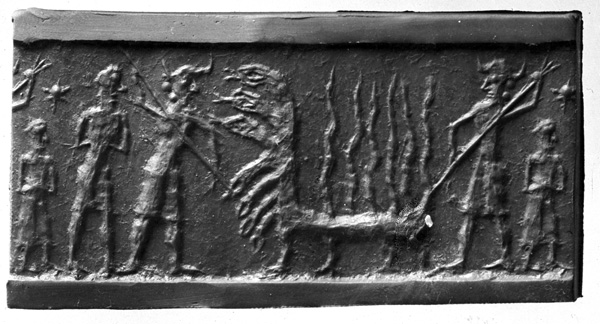It looks like you're using an Ad Blocker.
Please white-list or disable AboveTopSecret.com in your ad-blocking tool.
Thank you.
Some features of ATS will be disabled while you continue to use an ad-blocker.
share:
originally posted by: Spider879
Question for you Sumerologist and enthusiast , could Gilgamesh be the forerunner of Herakles, I remembered Bernal saying something to that effect.
As a literature enthusiast, and at this present time, I would be more inclined to place Enkidu in the Herakles tradition but that is quite a personal perspective (we are talking art here, so taste and inclination are fundamentally influencial), which could be swayed by better informed opinions than my own.
originally posted by: Spider879
Question for you Sumerologist and enthusiast , could Gilgamesh be the forerunner of Herakles, I remembered Bernal saying something to that effect.
I think there were many forerunners to Heracles, with Sargon the Great, Naram Sin, Nimrod and Gilgamesh/Enkidu and Bel Marduk all adding aspects to the story...
Tiamat for instance is depicted along with her brood as a multi headed dragon, hundreds of years before the foundation of Greek culture

Tiamat is the victim of Bel Marduk and he defeated her in water (Hydro)
So you have Heracles later defeating a creature which only ever appeared on trade cylinder seals, because the medium was so small that you couldn't draw all the other monsters in full.
Sargon the Great was a massive empire builder who declared himself divine, followed by his Grandson, Naram Sin, Gilgamesh derives his part God aspect from him, Nimrod, another empire builder who antagonised YAHWEH etc etc etc
If you can accept Heracles as completely fictional, then sources for his story come from all over. I don't think that there was one character though, who with just a name change becomes the Greek hero.
Anaana and Marduk much thanks to you both gotta reread some myths and legends I am very rusty, the Hydra like Tiamat is a good link.
originally posted by: Spider879
Anaana and Marduk much thanks to you both gotta reread some myths and legends I am very rusty, the Hydra like Tiamat is a good link.
Dragon imagery again,
All of these tales have their roots in the same era
This dragon has only 1 head

originally posted by: punkinworks10
originally posted by: Spider879
Anaana and Marduk much thanks to you both gotta reread some myths and legends I am very rusty, the Hydra like Tiamat is a good link.
Dragon imagery again,
All of these tales have their roots in the same era
This dragon has only 1 head
That's not a dragon its a cloud
All the first archetypal dragon stories have one thing in common
the dragons are always aquatic, the water theme pervades most all later dragon myths, This is because the dragon is either in the ocean, or in the sky, which all ancient cultures believed was water, this is the period in history where Gods are depicted travelling in boats in the sky.
Then the culture telling the story moves inland to develop agriculture and the stories are still told the same, but the dragon has legs, because the audience is no longer familiar with sea creatures
edit on 7-10-2015 by Marduk because: (no reason given)
edit on 7-10-2015 by Marduk because: (no reason given)
originally posted by: Marduk
Then the culture telling the story moves inland to develop agriculture and the stories are still told the same, but the dragon has legs, because the audience is no longer familiar with sea creatures
You mean like if there was a story about a how someone survived a tropical cyclone that destroyed a coastal community with a massive storm surge, rains and riverine flooding, and hurricane force winds, and the audience was a group of goat herders who had never seen a river or the sea, let alone experienced a tropical storm, then it might become a story about 40 days of rain flooding the world ..... Same basic story (man survives devastating flood), but details amended to suit the audience.
originally posted by: punkinworks10
a reply to: Marduk
Actually Marduk,
Its the Cheblynsk bolide, just before it broke up.
I didn't know that meteors were long and thin and cloud shaped like that, thanks
originally posted by: AndyMayhew
You mean like if there was a story about a how someone survived a tropical cyclone that destroyed a coastal community with a massive storm surge, rains and riverine flooding, and hurricane force winds, and the audience was a group of goat herders who had never seen a river or the sea, let alone experienced a tropical storm, then it might become a story about 40 days of rain flooding the world ..... Same basic story (man survives devastating flood), but details amended to suit the audience.
Yup, floods were the work of Gods, so any story that glorifies the power of a God is always retold bigger and better
Its almost as if the priesthood were deliberately retelling the stories that made more money for the temples. But of course, that's just me being cynical.
originally posted by: Marduk
originally posted by: punkinworks10
a reply to: Marduk
Actually Marduk,
Its the Cheblynsk bolide, just before it broke up.
I didn't know that meteors were long and thin and cloud shaped like that, thanks
Yes, large fireballs produce writhing snake like vapor trails. Imagine an ancient person seeing a very large fireball calve off several fragments, they sure might think it was multi headed dragon.
I've been lucky enough to two SPECTACULAR fireballs. One was the super famous one from 1972?
As it passed overhead it was still 100k feet up, and you could feel the heat on your face, and trailed billowing writhing clouds of smoke behind it, before it disappeared over the sierra nev. mtns.
The other was in 94-95, at night, I looked out my back window and the backyard was lit up in an odd twinkling green light, so I went out to see it pass overhead. Bright green and leaving a glowing vapor trail and calving fragments off.
After it disappeared over the horizon it blew up, its presumed to have broken up over the southern end of sequoia nat forest, about 120 miles away, but the shock wave was still strong enough to rattle my windows and shake the trees.
originally posted by: punkinworks10
Yes, large fireballs produce writhing snake like vapor trails. Imagine an ancient person seeing a very large fireball calve off several fragments, they sure might think it was multi headed dragon.
Nope, I'm pretty sure ancient people knew what a dragon looked like. Images of them were all over the place. Stories about them were read out as religious rites. The description always included at least details of the creatures form.
Tiamat for instance is described with
a tail, a thigh, "lower parts" (which shake together), a belly, an udder, ribs, a neck, a head, a skull, eyes, nostrils, a mouth, and lips. She has insides (possibly "entrails"), a heart, arteries, and blood.
and of course a very large mouth full of teeth...
In Africa and India, the monsters were more giant snakelike, mainly because those countries have large snakes, but even then, everyone knew what a giant snake looked like, they lived with them.
Your bolide image would have been more likely to be seen as an omen from the Gods sending all the priests rushing to their texts to see what it meant.
Ancient peoples were just as intelligent as us, but were much more familiar with their own mythology than we are.
edit on 7-10-2015 by Marduk because: (no reason given)
originally posted by: stormcell
But there should be skeletons, fossilized tree roots and seeds somewhere ?
I'm pretty sure that by now, the existence of forests in that part of the world in ancient times is well established. It's part of the gradual changes in climate that followed the last glacial maximum around ~12,000 BCE. Northern Europe was under ice and the sort of climate that is in the far North now was found significantly further south. It transitioned between that and what we have today and more or less had to gradually do so by transitioning through every intermediary step.
So while not specifically and exactly true, think of it like the whole distribution of climate zones was shifted south a few hundred miles at 12,000 BCE. Then the climate gradually warmed and glaciers retreated, i.e. the zones were shifting warmer to the north, and the plants and animals that went with each zone followed it as it moved northward over time. Wet vs dry is a different variable than warm/cold though and so some places also shifted wet to dry or dry to wet for complex reasons.
You can see the same thing on mountains in some places. The sorts of plants and animals you find changes the higher up you go. You can see that you often find leafy trees low on a mountain, but go up higher and you'll only find pine type trees. Recovering from glaciers, the pine forests return first for hundreds or thousands of years, and then if things keep warming, the deciduous (leafy) trees will move in and out compete the pines for the same space.
new topics
-
Fire insurance in LA withdrawn months ago
General Conspiracies: 1 hours ago -
Bizarre Labour Party Tic Toc Video Becomes Even More Embarrassing
Regional Politics: 9 hours ago
top topics
-
The elephant in the room (wearing a hoodie)
US Political Madness: 16 hours ago, 14 flags -
Dr. Demento
Music: 16 hours ago, 6 flags -
Fire insurance in LA withdrawn months ago
General Conspiracies: 1 hours ago, 5 flags -
Bizarre Labour Party Tic Toc Video Becomes Even More Embarrassing
Regional Politics: 9 hours ago, 4 flags -
Potter to WHU
World Sports: 14 hours ago, 2 flags
active topics
-
Fire insurance in LA withdrawn months ago
General Conspiracies • 5 • : BeyondKnowledge3 -
-@TH3WH17ERABB17- -Q- ---TIME TO SHOW THE WORLD--- -Part- --44--
Dissecting Disinformation • 3979 • : Guyfriday -
Los Angeles brush fires latest: 2 blazes threaten structures, prompt evacuations
Mainstream News • 285 • : marg6043 -
Judge rules president-elect Donald Trump must be sentenced in 'hush money' trial
US Political Madness • 84 • : Vermilion -
S.C. Jack Smith's Final Report Says Trump Leads a Major Conspiratorial Criminal Organization!.
Political Conspiracies • 47 • : Vermilion -
Statements of Intent from Incoming Trump Administration Members - 2025 to 2029.
2024 Elections • 61 • : cherokeetroy -
Gravitic Propulsion--What IF the US and China Really Have it?
General Conspiracies • 39 • : budbayview -
The elephant in the room (wearing a hoodie)
US Political Madness • 26 • : xuenchen -
Its Looking Like Schiff - Vindman - Ciaramella Conspired to Impeach President Trump.
Political Conspiracies • 188 • : WeMustCare -
Trump's idea to make Canada the 51st US state: 'Potential is massive'
Mainstream News • 155 • : DaydreamerX
